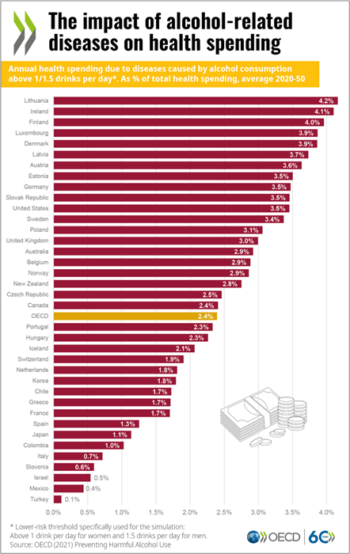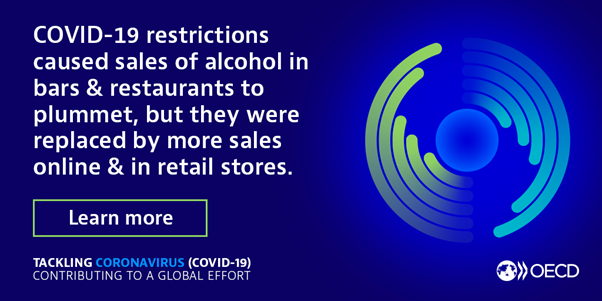The report entitled “Preventing Harmful Alcohol Use” estimates that for every US$ 1 invested in high-impact alcohol policy solutions, up to US$ 16 is returned in economic benefit, reports London Loves Business.
Analysis of 52 OECD, European Union and Group of 20 (G20) countries shows that life expectancy will be 0.9 years lower over the next 30 years due to diseases and injuries caused by alcohol consumption.
Alcohol harm and alcohol policy impact are UNDERestimated
The OECD calculates in its simulation with a threshold for harm from alcohol consumption beyond 1 alcoholic drink per day for women and 1.5 drinks per day for men. This is controversial because science has established that no amount of alcohol use is safe or healthy, for instance concerning brain health or cancer. Including all alcohol consumption in the modelling simulations would therefore further increase the alcohol burden and the returns on investment from evidence-based alcohol policy-making.
In recent years, landmark studies have shown that there is no safe level of alcohol consumption and that any amount of alcohol consumption is harmful, for example for brain health, cardiovascular diseases and cancer.
We welcome the report and congratulate the OECD for this timely contribution to make alcohol harm a public health priority,” says Kristina Sperkova, International President of Movendi International.
This report contains a number of important findings that contribute to further strengthening the case for accelerating action on alcohol prevention and control. Millions of lives can be saved, billions of dollars can be saved and significant returns can be achieved by investing in comprehensive alcohol policy blue prints.
But in studying the report, we also noticed the persisting problem that alcohol harm continues to be under-estimated and that especially alcohol availability measures should have featured more prominently in the analysis and prevention package.”
Kristina Sperkova, International President, Movendi International
This estimate varies widely across countries, which reflects the level of alcohol consumption, the level of alcohol policy development and the provision of health care services. The largest reductions in life expectancy are estimated in Central and Eastern European countries.
Alcohol consumption and harm
Alcohol-related diseases and injuries incur a high cost to society. Life expectancy is nearly one year lower than it would be, on average, if alcohol consumption in a population would be lower.
An average of 2.4% of health spending goes to dealing with the harm caused by alcohol consumption – and the figure is much higher in some countries. In addition, poor health due to alcohol consumption has detrimental consequences on labour participation and productivity.
Combined with the impact on labour force productivity, it is estimated that GDP will be 1.6% lower on average in OECD countries annually over the next 30 years, varying from 0.2% in Turkey to 3.8% in Lithuania.
Reduced productivity of employees amounts to US$ 595 billion (adjusted for purchasing power), according to the report.
COVID-19 and alcohol use and harm
The report includes analysis of the impact of the COVID-19 pandemic on alcohol consumption in the populations of OECD countries and patters of alcohol use. It finds a higher number of people reporting an increase in volume and frequency of alcohol use compared to the number of people who have reduced their alcohol use.
In Germany, the United Kingdom and the United States, overall alcohol sales increased by 3 to 5% during the pandemic compared to 2019, according to preliminary estimates.
During the lockdowns, women, parents of young children, people with higher income and those with anxiety and depressive symptoms reported the highest increase in alcohol consumption, for instance in Australia, Belgium, France, the United Kingdom and the United States.
COVID-19 counter-measures, including alcohol policy solutions to curb the spread of the coronavirus, caused alcohol sales in the on-trade sector, such as bars and restaurants, to tumble. But they were replaced by rising alcohol sales in retail stores and online, through on-demand delivery services. This shift in the venue of alcohol consumption has also contributed to specific alcohol harms further rising. For example, emergency calls about domestic violence rose by 60% in EU countries. Alcohol is a major risk factor for violence.
A triple dividend
The OECD also outlines the triple dividend of preventing alcohol harm. Investing in evidence-based, high-impact alcohol policy solutions helps achieve three positive outcomes, in the context of the pandemic:
- Alcohol policy solutions help protect people’s immune system during COVID-19,
- Alcohol policy solutions help protect societies’ health system functioning, and
- Alcohol policy solutions contribute to a healthier and more productive population.
This is turn has significant implications for restarting and recovering from the pandemic. Alcohol policy solutions hold significant potential to help build back better.
This matters because OECD also predicts further rising alcohol problems due to the pandemic.
Alcohol policy solutions and return on investment
Analysis of national efforts to prevent and reduce alcohol harm reveals that in many countries gaps remain in the development and implementation of proven policies.
These gaps persist in areas of alcohol policy making that yield the biggest return on investment and have the biggest cost-effectiveness, such as:
- Regulating the price of alcohol, through taxation and/ or minimum unit pricing,
- Limiting alcohol availability,
- Regulating alcohol marketing,
- Improving driving under the influence counter-measures,
- Improving screening and brief interventions, and
- Better regulating consumer information, for example through health warning labelling.
For example, alcohol has become cheaper in the OECD because of flawed alcohol taxation practices where governments fail to raise alcohol taxes adequately, to at least adjust alcohol taxation to inflation rates, and to ensure affordability decreases.
The OECD concludes that a comprehensive approach to alcohol harm, closing these gaps in alcohol policy development and implementation brings health benefits to the entire population, and helps save money. Whole of population interventions have the biggest impact according to the OECD microsimulation, as report author Michele Cecchini explains in the Alcohol Issues Podcast with Maik Dünnbier of Movendi International.
The OECD report shows that there is a strong economic case for upscaling investment in alcohol policy. So called prevention packages are recommended.
- The Prevention Packages could save 3.5 million life years and US$ PPP 16 billion every year.
- Investing in Minimum Unit Pricing could save US$ 207 billion (adjusted for purchasing power), according to the OECD.
These gains can be achieved through a comprehensive approach to alcohol policy. The OECD calls it the “4P Package”. The 4Ps of the intervention package reflect WHO’s SAFER alcohol policy blue print, and shows the potential of integrated approaches to alcohol policy:
- Pricing – limit the affordability of alcohol, especially by eliminating ultra-cheap alcohol,
- Promotion – ban alcohol advertising, especially to protect children and including online alcohol advertising,
- Policing – improve law enforcement, for instance of driving under the influence counter-measures, and provide better services to victims of alcohol violence, and
- Primary care – invest to support people experiencing alcohol problems and alcohol use disorder. Currently, less than 10% receive the healthcare they need.
This alcohol policy package would have the biggest impact on the pervasive alcohol harm across the OECD, according to the report. Implementation of the 4P Package promises savings of US$ 28 billion in health expenditure, according to Michele Cecchini, as per the Alcohol Issues Podcast episode 19. This is broadly equivalent to the current health spending in Israel or half the current health spending in Sweden.
Tackling alcohol harm is an excellent investment, for every US$1 invested it yields a return of ca. $16.4 from the “Prevention Package”.
We welcome the report and congratulate the OECD for this timely contribution to make alcohol harm a public health priority,” says Kristina Sperkova, International President of Movendi International. Movendi International is the largest global social movement advocating for evidence-based alcohol policy development.
This report contains a number of important findings that contribute to further strengthening the case for accelerating action on alcohol prevention and control. Millions of lives can be saved, billions of dollars can be saved and significant returns can be achieved by investing in comprehensive alcohol policy blue prints.
Alcohol harm is pervasive across OECD countries and we can see the suffering and have to face the damage in our communities everyday. But this new report illustrates emphatically that alcohol policy solutions hold tremendous potential to improve the social and economic well-being of our societies.
Therefore, this report should move our governments into action because through alcohol policy making we can recover and build back better after the pandemic.”
Kristina Sperkova, International President, Movendi International
Cite the report
OECD (2021), Preventing Harmful Alcohol Use, OECD Health Policy Studies, OECD Publishing, Paris, https://doi.org/10.1787/6e4b4ffb-en.
For further reading
Download the report.
Download the accompanying policy brief on the effect of COVID-19 on alcohol consumption.
Download the OECD country notes.


